Ways To Help Keep Peach Borers at Bay

The larvae of adult lesser peach tree borers feed and tunnel in phloem, the tissue between outer bark and wood. Such tunneling can girdle and kill young trees. Pheromone mating disruption prevents male and female borers from creating such larvae.
Photo by Eugene E. Nelson, Bugwood.org
Peach tree borers (PTB) and lesser peach tree borers (LPTB) affect not just the Southeast but also the entire East Coast, according to Brett Blaauw, a peach entomologist and Associate Professor with the University of Georgia and Clemson University.
Fortunately for peach growers and other stone fruit farmers, pheromone mating disruption continues to perform well against the insects in the wake of the March 2022 federal ban on chlorpyrifos. Blaauw updated the state of PTB and LPTB management during a stone fruit webinar presented by the Eastern New York Commercial Horticulture Program.
CLOUD CREATION
Although several companies have pheromone products in the works, according to Blaauw, peach growers are currently limited to one option. Isomate PTB Dual, distributed in the West by manufacturer Pacific Biocontrol and in the East by CBC America, applies to PTB and LPTB. Growers in Georgia and South Carolina rely on a specific formulation of the product, Isomate LPTB Plus, because of its increased longevity in the South, according to Blaauw.
Placement of the product’s pheromone dispensers within the orchard — done manually using twist ties — should approach 150 per acre and up to 250 per acre in high-pressure areas, Blaauw says.
“Depending on your density, this could be one per tree or two per tree,” he says. “Putting them on basically every tree in the orchard creates that big cloud to help stop the males from finding the females.”
The dispensers should be deployed prior to moth emergence in the spring, which is typically just prior to bloom. As for placement, Blaauw targets lateral branches about mid-height in the canopy.
“You don’t want to put them too low or too high but about mid-range,” he says. “I usually put them all about eye level, but I’m only 5 (foot) 7.”
At that point, the legwork is finished for growers … until the following season.
“What’s really nice is you put those out once that season, and it works all season long. You don’t have to worry about coming out and reapplying them or applying them multiple times a season,” Blaauw says. “However, they only work one season, so you have to come back each season to apply them.”
ONE FOR ALL, ALL FOR ONE
The primary caveat of pheromone mating disruption centers on the need for area-wide application to guarantee true efficacy, Blaauw says. If dispensers are deployed in only one of two neighboring orchards, the mated PTB and LPTB females in the untreated orchard are just as likely to move to the mating disruption orchard just a few hundred yards away.
“Any orchard that is within about a half-mile to a mile apart needs to be under disruption,” Blaauw says. “And that can be a problem if you have neighbors that are also growing peaches. You need to really work with them.”
Orchards located on strong slopes also run the risk of uneven pheromone distribution.
“If you’re growing peaches in the mountains, you’re not going to get even pheromone distribution because the pheromone is heavier than air,” Blaauw says. “You’re going to get a gradient of that pheromone. But I have seen it work in mountains in some places.”
Gaps in orchards where trees have died will also decrease pheromone production, Blaauw says. This is “incredibly common” in Georgia because of Armillaria root rot, he says.
Finally, growers who experience high insect pressure year to year may need to apply insecticides as well as pheromones, particularly in the first year of incorporating mating disruption.
“For that first year, I wouldn’t just go cold turkey, especially in these high-pressure orchards,” Blaauw says.










